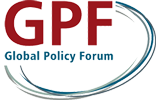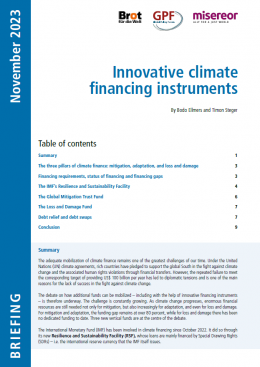The adequate mobilization of climate finance remains one of the greatest challenges of our time. Under the United Nations (UN) climate agreements, rich countries have pledged to support the global South in the fight against climate change and the associated human rights violations through financial transfers. However, the repeated failure to meet the corresponding target of providing US$ 100 billion per year has led to diplomatic tensions and is one of the main reasons for the lack of success in the fight against climate change.
The debate on how additional funds can be mobilized – including with the help of innovative financing instruments – is therefore underway. The challenge is constantly growing. As climate change progresses, enormous financial resources are still needed not only for mitigation, but also increasingly for adaptation, and even for loss and damage. For mitigation and adaptation, the funding gap remains at over 80 percent, while for loss and damage there has been no dedicated funding to date. Three new vertical funds are at the centre of the debate.
The International Monetary Fund (IMF) has been involved in climate financing since October 2022. It did so through its new Resilience and Sustainability Facility (RSF), whose loans are mainly financed by Special Drawing Rights (SDRs) – i.e. the international reserve currency that the IMF itself issues.
A second fund is the Loss and Damage Fund (LDF). The decision by the UN Climate Summit in 2022 to create a new fund for loss and damage has been seen as a breakthrough in this area. One of the many unresolved issues is how the LDF should be financed. Among the numerous financing proposals, non-governmental organisations (NGOs) in particular prefer new progressive taxes, from wealth tax to excess profit tax for energy companies.
The third fund is the Global Mitigation Trust Fund (GMTF), part of the Bridgetown Initiative to reform the international financial architecture. This was launched by Mia Mottley, the Prime Minister of Barbados, and UN Secretary-General António Guterres in the run-up to the UN climate summit in 2022. This new fund is also to be fed primarily from SDRs. It aims to reduce the high financing costs for private investments in the global South – for example, in the field of renewable energies – to a comparatively low level, as in Germany. With a capital stock of SDRs worth US$ 500 billion, the GMTF is expected to mobilize up to US$ 5 trillion in private investments in the future.
While the new funds are intended to transfer additional money to the global South, there is a simultaneous debate about how the outflow of funds from countries can be stopped so that scarce domestic budgetary resources can be used directly for climate financing. Temporary debt moratoriums are being discussed, which could increase the fiscal leeway for financing loss and damage in the event of climate-related disasters. More far-reaching steps, such as debt swaps of individual creditor’s loans or large-scale debt restructuring of a country’s entire debt portfolio can permanently release scarce fiscal resources and make them available for mitigation and adaptation.
The selected examples of innovative financing show that there are numerous options for reducing the gaps in climate financing. A combination of additional international financial transfers, innovative tax types and money creation through SDRs, as well as the release of countries’ own budget funds through debt relief, has high mobilization potential. The hurdles that need to be overcome are mainly political in nature. The international political calendar offers numerous opportunities over the coming months to initiate the necessary reforms.
By Bodo Ellmers and Timon Steger
Published by Brot für die Welt, Global Policy Forum Europe, and Misereor
Aachen/Berlin/Bonn, November 2023

